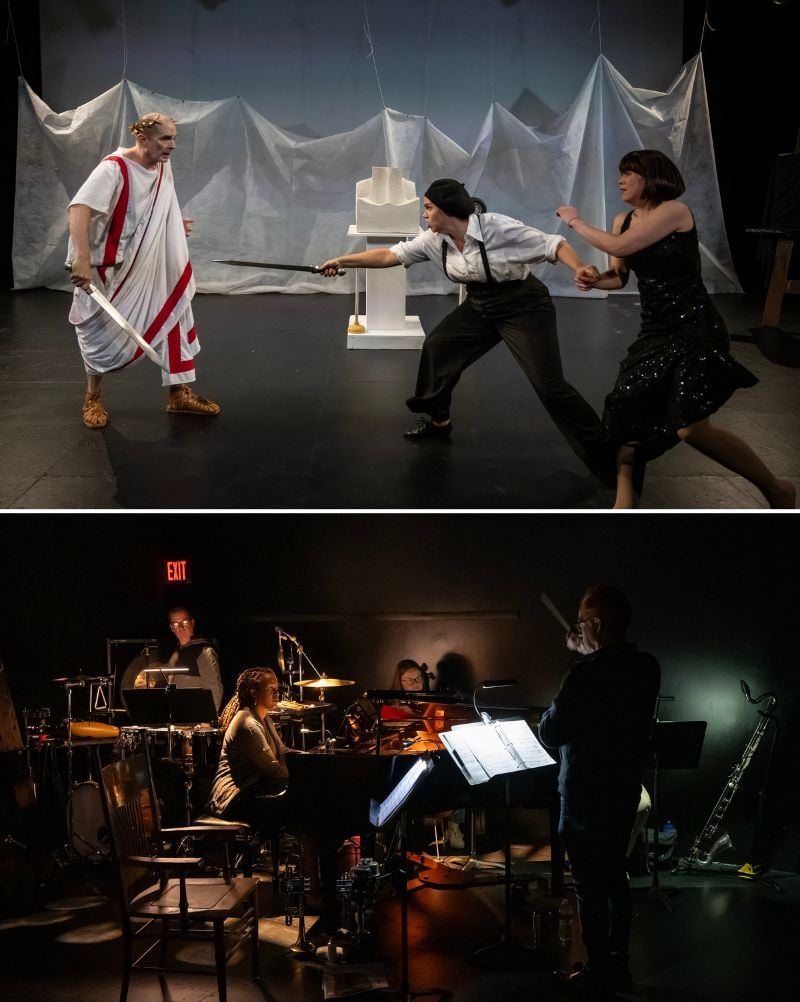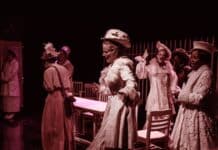A mashup of Marx Brothers pratfalls and Machiavellian politics feels about right for this Presidential election season. That Alliance for New Music-Theatre has been working for four years on a comic chamber opera taking seriously both Marx — that is, the brothers — and Machiavelli, with tongue firmly in cheek, makes this seriously funny 90-minute one-act both prescient and precocious.
Inspired by American visual artist Man Ray’s painting “Shakespearean Equation: Julius Caesar” — pop over to the Phillips Collection to see it on canvas — the musical aims to lean into the Dadaist principles that inspired Man Ray.

The Man Ray Project: Caesar & The Mannequin, developed by librettist Susan Galbraith, a co-founder of the Alliance, and composer and company member Andrew Earle Simpson, opens with foreboding bass notes, the cello’s voice chimes in and is answered by the piano. The evening is divided into three sections named arguments in the classical philosophical sense. We meet beret-wearing Wo-Man Ray, who schools us in a great list patter song: “Possibilities & The Seven Elements of Art.” Then from behind a curtain, Caesar enters spouting his so-called “Greatest Hits”: “Veni Vidi Vici” et al. from Shakespeare. This Caesar in his red-trimmed Roman robe toggles between maniacal and mundane, exhorting to build a new Rome.
The ingenue, Kiki, comes from Man Ray’s influence — she was a Parisian artists’ model and muse, as well as a painter and Man Ray’s common-law wife. Clad in a black sequined gown and turban, she’s chic both in pointe shoes and barefoot, as a seductress and put-upon woman in a male-dominated relationship. Screening on the backdrop, period black-and-white films depict the collection of junk — found items that became Dadaist readymades for display — that appeal to collage artists’ experimentation as well as films of Man Ray’s works, including his eponymous “Rayographs” — photos made without a camera on light-sensitive photo paper.
Caesar, Kiki, and Wo-Man Ray have philosophical spats in song — competing on vocal trills — in this odyssey. The repartee ranges from nods to the Gallic wars to grammar lessons on the correlative conjunction to the artist as god figure in creative pursuit of the universe.
The staging area features a pedestal with a curved half-open pair of columnar sculpture at center stage, while a shrouded easel stands to one side, a pair of low box-like benches at the other, and a closet door, with the initial caption overhead reading “Caesar & The Mannequin,” allows for entrances and exits. A roll-on chalkboard provides a space to replicate Man Ray’s Dadaist mathematical meanderings — 2+2=22 — which appear in his enigmatic painting series “Shakespearean Equations.” And, finally, a wheeled single table leg serves as an oddball prop, until the final reveal. In the painter’s mind, it has been written, that upside down table leg is, in fact, Caesar — or at least his scepter.

In portraying Caesar as part dictator, part dodo, and Man Ray as a Wo-Man — played by Cara Schaefer — Galbraith and Simpson, the creative team, emasculates these hyper-controlling and macho historic figures, allowing us to re-think power structures in both political and artistic realms.
Composer Andrew Earle Simpson’s pastiche score draws on classic operetta, tango, carnival music, jazz, blues, marches, and Sondheim to name a few of the stylistic music choices finely played by the five-piece ensemble featuring Susan Rider, Chris Reardon, Emily Doveala, Liz Hill, and Chris DeChiara or Glenn Paulson.
The Man Ray Project — with its mixed-media approach and its political take on power-hungry men, whether from ancient history or modern art — is thoughtfully and mostly engagingly produced. While its slapstick and Dadaist leanings come through in script, music, and design, the performers John Boulanger as Caesar, Schaefer and Wo-Man Ray, and Danielle McKay as Kiki or the Mannequin need some more time to inhabit their iconic and ironic characters fully. Finessing slapstick, comedy, and cheekiness isn’t easy. A bit more comfort in their roles will make this Dadaist spectacle reach its potential.
Running Time: 90 minutes, no intermission.
The Man Ray Project: Caesar & the Mannequin plays through September 22, 2024, presented by Alliance for New Music-Theatre performing at Atlas Performing Arts Center, 1333 H Street NE, Washington, DC. Tickets ($25–$45) are available online.
The Man Ray Project: Caesar & The Mannequin
PRODUCTION
Andrew E. Simpson: Composer, Music Director
Susan Galbraith: Librettist/Stage Director
Anne Fisher: Choreographer
Casey Kaleba: Fight Director
Wendy Grossman: Man Ray Art Consultant
Blanca Gruber: Cinematographer
Dasha Pomerantseva: Costume Designer
Matty Griffiths: Production /Stage & Tech Manager
CAST
John Boulanger: Caesar
Cara Schaefer: Wo-Man Ray
Danielle McKay: The Mannequin
MUSICIANS
Susan Rider: Trumpeter / Custodian
Liz Hill: Accompanist, Pianist
Chris Reardon: Clarinet/Bass Clarinet
Emily Doveala: Cello
Chris DeChiara: Percussion
Glenn Paulson: Percussion 9/13, 9/14, 9/15, 9/20



